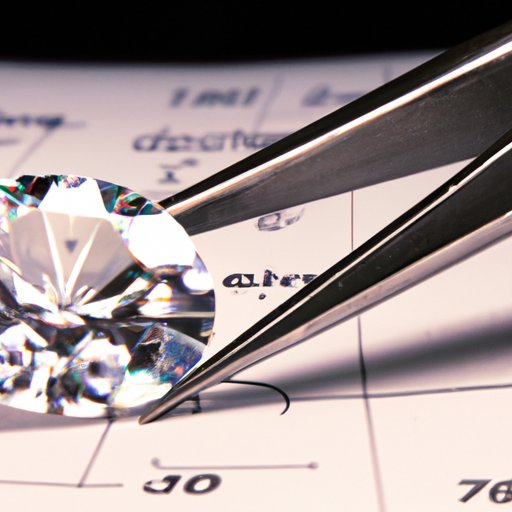Introduction
Lab diamonds, also known as man-made diamonds, are a type of gemstone created in a laboratory setting. They are made with the same chemical, physical, and optical properties as natural diamonds, but they cost significantly less than their natural counterparts. Lab diamonds have become increasingly popular in recent years, and many people are now choosing them over natural diamonds for their jewelry investments.

How Lab Diamonds are Changing the Jewelry Industry
Lab diamonds have been gaining traction in the jewelry industry due to their ability to provide an affordable alternative to traditional diamonds. As the demand for lab diamonds grows, the natural diamond market is being impacted. In addition, the accessibility of lab diamonds has made them a more attractive option for those looking to purchase diamond jewelry.
The Pros and Cons of Lab-Created Diamonds
Lab diamonds offer a number of benefits, such as cost savings and environmental sustainability. However, there are also some drawbacks to consider. Let’s take a look at the pros and cons of lab diamonds.
Cost
One of the main advantages of lab diamonds is the cost savings. On average, lab diamonds cost up to 40% less than natural diamonds of the same size and quality. This makes them a great option for those on a budget who still want to purchase a beautiful piece of jewelry.
Durability
Lab diamonds are just as durable as natural diamonds. They can handle everyday wear and tear without losing their shine or sparkle. This makes them a great choice for those who want a piece of jewelry that will last a lifetime.
Environmental Impact
Another benefit of lab diamonds is their reduced environmental impact. Natural diamonds require mining, which can be damaging to the environment. Lab diamonds, on the other hand, are created in a controlled lab setting and do not require any mining.
Resale Value
One potential downside of lab diamonds is their resale value. Because they are not considered to be “real” diamonds, they do not typically retain their value as well as natural diamonds. Therefore, it is important to consider this factor when making your decision.
Breaking Down the Basics of Lab Diamonds
If you’re considering purchasing a lab diamond, there are a few things you should know about them. Let’s take a look at the basics of lab diamonds.
Types of Lab Diamonds
Lab diamonds come in a variety of types, including synthetic diamonds and cultured diamonds. Synthetic diamonds are created in a lab using high pressure and heat, while cultured diamonds are grown from a seed crystal in a lab. Both types of diamonds offer the same chemical, physical, and optical properties as natural diamonds.
Quality and Grading
Lab diamonds are graded in the same way as natural diamonds, using the 4C’s system (cut, color, clarity, and carat weight). When shopping for a lab diamond, it is important to make sure that the diamond is certified by a reputable laboratory, such as the Gemological Institute of America (GIA). This ensures that the diamond meets the highest standards of quality and grading.

What You Need to Know Before Purchasing a Lab Diamond
Before purchasing a lab diamond, there are a few things you should keep in mind. Here are a few tips to help you make the best decision.
Certification
Make sure to check the certification of the lab diamond before making your purchase. A reputable laboratory, such as the GIA, should certify the diamond to ensure its quality and authenticity. Ask for a copy of the certificate to make sure that the diamond meets the highest standards.
Warranties
It is also important to ask about any warranties that come with the lab diamond. Most reputable jewelers will offer a warranty for their lab diamonds, so make sure to inquire about this before making your purchase.
An Overview of Lab Diamonds: Is it Worth the Investment?
Lab diamonds offer a number of benefits and advantages, including cost savings, durability, and environmental sustainability. However, they do not have the same resale value as natural diamonds, so it is important to consider this before making your decision. Ultimately, the decision to purchase a lab diamond comes down to personal preference and budget.
Considerations for Potential Buyers
When deciding whether or not to purchase a lab diamond, it is important to weigh the pros and cons. Consider your budget, the type of diamond you want, and the quality of the diamond before making your purchase. It is also important to make sure that the diamond is certified and comes with a warranty.
Final Thoughts
Lab diamonds are becoming increasingly popular in the jewelry industry. They offer a cost-effective alternative to natural diamonds, while still providing the same chemical, physical, and optical properties. Before investing in a lab diamond, it is important to consider the pros and cons, the type and quality of the diamond, and the certification and warranties that come with it.
Conclusion
Lab diamonds are a great option for those looking for an affordable and sustainable alternative to natural diamonds. They offer the same chemical, physical, and optical properties, and can be found in a variety of types and qualities. Before investing in a lab diamond, it is important to consider the pros and cons, the type and quality of the diamond, and the certification and warranties that come with it.


